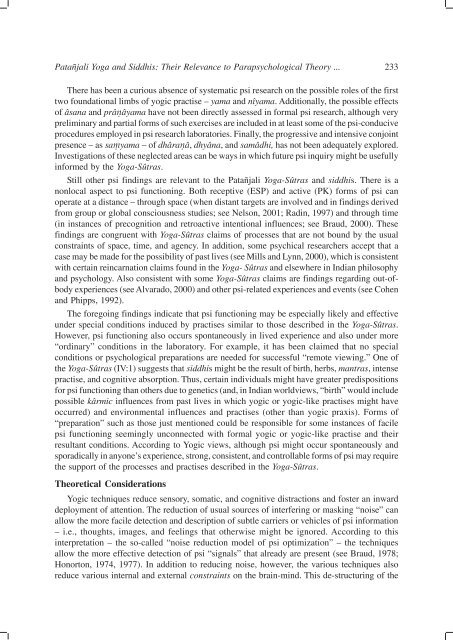Patañjali Yoga and Siddhis - Inclusive Psychology
Patañjali Yoga and Siddhis - Inclusive Psychology
Patañjali Yoga and Siddhis - Inclusive Psychology
You also want an ePaper? Increase the reach of your titles
YUMPU automatically turns print PDFs into web optimized ePapers that Google loves.
<strong>Patañjali</strong> <strong>Yoga</strong> <strong>and</strong> <strong>Siddhis</strong>: Their Relevance to Parapsychological Theory ... 233<br />
There has been a curious absence of systematic psi research on the possible roles of the first<br />
two foundational limbs of yogic practise – yama <strong>and</strong> nîyama. Additionally, the possible effects<br />
of âsana <strong>and</strong> prâƒâyama have not been directly assessed in formal psi research, although very<br />
preliminary <strong>and</strong> partial forms of such exercises are included in at least some of the psi-conducive<br />
procedures employed in psi research laboratories. Finally, the progressive <strong>and</strong> intensive conjoint<br />
presence – as sa√yama – of dhâraƒâ, dhyâna, <strong>and</strong> samâdhi, has not been adequately explored.<br />
Investigations of these neglected areas can be ways in which future psi inquiry might be usefully<br />
informed by the <strong>Yoga</strong>-Sûtras.<br />
Still other psi findings are relevant to the <strong>Patañjali</strong> <strong>Yoga</strong>-Sûtras <strong>and</strong> siddhis. There is a<br />
nonlocal aspect to psi functioning. Both receptive (ESP) <strong>and</strong> active (PK) forms of psi can<br />
operate at a distance – through space (when distant targets are involved <strong>and</strong> in findings derived<br />
from group or global consciousness studies; see Nelson, 2001; Radin, 1997) <strong>and</strong> through time<br />
(in instances of precognition <strong>and</strong> retroactive intentional influences; see Braud, 2000). These<br />
findings are congruent with <strong>Yoga</strong>-Sûtras claims of processes that are not bound by the usual<br />
constraints of space, time, <strong>and</strong> agency. In addition, some psychical researchers accept that a<br />
case may be made for the possibility of past lives (see Mills <strong>and</strong> Lynn, 2000), which is consistent<br />
with certain reincarnation claims found in the <strong>Yoga</strong>- Sûtras <strong>and</strong> elsewhere in Indian philosophy<br />
<strong>and</strong> psychology. Also consistent with some <strong>Yoga</strong>-Sûtras claims are findings regarding out-ofbody<br />
experiences (see Alvarado, 2000) <strong>and</strong> other psi-related experiences <strong>and</strong> events (see Cohen<br />
<strong>and</strong> Phipps, 1992).<br />
The foregoing findings indicate that psi functioning may be especially likely <strong>and</strong> effective<br />
under special conditions induced by practises similar to those described in the <strong>Yoga</strong>-Sûtras.<br />
However, psi functioning also occurs spontaneously in lived experience <strong>and</strong> also under more<br />
“ordinary” conditions in the laboratory. For example, it has been claimed that no special<br />
conditions or psychological preparations are needed for successful “remote viewing.” One of<br />
the <strong>Yoga</strong>-Sûtras (IV:1) suggests that siddhis might be the result of birth, herbs, mantras, intense<br />
practise, <strong>and</strong> cognitive absorption. Thus, certain individuals might have greater predispositions<br />
for psi functioning than others due to genetics (<strong>and</strong>, in Indian worldviews, “birth” would include<br />
possible kârmic influences from past lives in which yogic or yogic-like practises might have<br />
occurred) <strong>and</strong> environmental influences <strong>and</strong> practises (other than yogic praxis). Forms of<br />
“preparation” such as those just mentioned could be responsible for some instances of facile<br />
psi functioning seemingly unconnected with formal yogic or yogic-like practise <strong>and</strong> their<br />
resultant conditions. According to Yogic views, although psi might occur spontaneously <strong>and</strong><br />
sporadically in anyone’s experience, strong, consistent, <strong>and</strong> controllable forms of psi may require<br />
the support of the processes <strong>and</strong> practises described in the <strong>Yoga</strong>-Sûtras.<br />
Theoretical Considerations<br />
Yogic techniques reduce sensory, somatic, <strong>and</strong> cognitive distractions <strong>and</strong> foster an inward<br />
deployment of attention. The reduction of usual sources of interfering or masking “noise” can<br />
allow the more facile detection <strong>and</strong> description of subtle carriers or vehicles of psi information<br />
– i.e., thoughts, images, <strong>and</strong> feelings that otherwise might be ignored. According to this<br />
interpretation – the so-called “noise reduction model of psi optimization” – the techniques<br />
allow the more effective detection of psi “signals” that already are present (see Braud, 1978;<br />
Honorton, 1974, 1977). In addition to reducing noise, however, the various techniques also<br />
reduce various internal <strong>and</strong> external constraints on the brain-mind. This de-structuring of the






